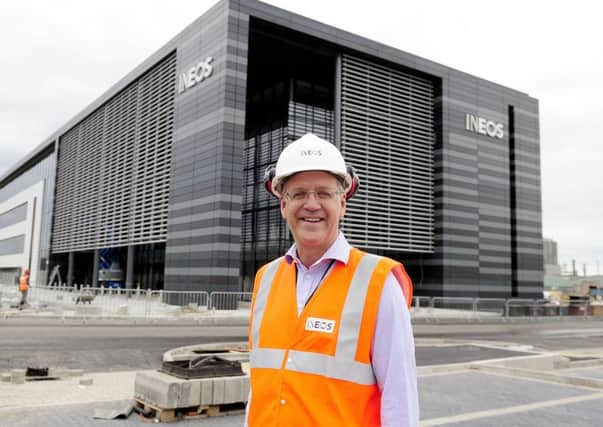Ineos in it for the long haul


The skyline around the port town is changing on a regular basis as the petrochemical company turns its promises to invest into actions.
Pointing to a huge photograph displayed on the wall of its business centre, chief executive John McNally reveals what areas of the 1700 acres have been cleared and where building work is currently underway.
Advertisement
Hide AdAdvertisement
Hide AdHe said: “It’s all about bringing back pride to the site. We’re currently involved in a very big programme of decommissioning old kit that is never coming back up and that will clear up the area.
“It’s demoralising for people to see rusty pipework but if we can clean up the site that hopefully will pave the way to bring in new investment.”
The company, which has grown to be the fourth largest chemical company in the world, has invested £450 million in Grangemouth since the dark days of 2013.
It continues to pledge that importing shale gas from the United States will secure the future of the site as the supply of fuel from the North Seas continues to dwindle.
Advertisement
Hide AdAdvertisement
Hide AdA new £200 million tank will store the shale gas after it is transported across the Atlantic in specially constructed tankers, the first of which is due to arrive in Grangemouth in little over two months.
The company expects to be shipping 40,000 barrels of US gas every day for the next 15 years.
Work on building a new office block continues at pace. The sleek black and chrome building adjacent to Inchyra Road will see staff housed in a 21st century building which Mr McNally says reflects the firm’s commitment to look after its workforce and bring them together in a way that will best suit the business.
Designed by award-winning Scottish firm Michael Laird Architects, it has three floors of open plan office space above a ground floor which will boast meeting rooms, a coffee shop and even a gym.
Advertisement
Hide AdAdvertisement
Hide AdEmploying around 1350 people, Ineos remains one of the district’s biggest employers and continues to attract people.
It currently has 79 modern apprentices and 20-plus engineers of the future with its latest recruitment process for apprenticeships bringing around 400 applications.
Mr McNally, who has been CEO of Ineos Olefins and Polymers UK for the last decade, added: “We don’t want to train people up for them to leave us, we want them to have a long-term future with Ineos.”
“I believe it reflects well on us as a company by how many fathers and sons, mothers and daughters, are working for us.
Advertisement
Hide AdAdvertisement
Hide AdHe said: “This is the biggest site Ineos owns. In its heyday it was the biggest money spinner.
“There are currently 58 sites in the Ineos group and our owner Jim Ratcliffe has put out a decree that all the rest have to do what Grangemouth is doing.
“It’s not made me popular with other CEOs but it shows that what we are doing is the way ahead.”
Weather warning over fuel supplies
A few cold winters would make people realise how “fragile” the UK’s fuel reserves are, according to John McNally.
Advertisement
Hide AdAdvertisement
Hide AdThe Ineos CEO believes the country’s leaders should be embracing the use of shale gas – and allowing companies to drill wells to capitalise on the resource beneath our feet.
However, currently Scottish ministers have a moratorium in place which bans the granting of planning consent for fracking – the means for extracting shale gas from underground.
Implemented in January 2015, last October the Scottish Government announced it will not take a final decision on whether to allow fracking in Scotland until the Spring of 2017 at the earliest.
However, in June MSPs voted by 32 votes to 29 to have a full fracking ban when taking part in an environment debate. All the SNP members abstained.
Advertisement
Hide AdAdvertisement
Hide AdIneos has exploration licences for unconventional gas across Central Scotland, but with the moratorium in place is concentrating is focusing fracking activity around its Hull site in the north of England.
But Mr McNally believes the country should be taking steps now to capture the indigenous shale resource.
“It’s not black magic, rather its well-established technology,” he emphasised. “There are over one million shale gas wells in the United States. Properly policed it provides a valuable resource.
“Shale gas is a feedstock I can use to provide power for the UK. Currently 65 per cent of our natural gas is being imported because we don’t have enough. But there is a supply under our feet that we could make use of.
Advertisement
Hide AdAdvertisement
Hide Ad“It would only take a couple of cold winters for people to realise how fragile our supply is.”
While the arrival of the first tankers from the US in a few months time will undoubtedly be greeted with a fanfare, Mr McNally would much rather be was witnessing the first wells being drilled on Scottish soil.